Are Barnacles Bad For Turtles?
Barnacles are a type of marine crustacean that are known to attach themselves to the shells of turtles. They are a common sight on turtles in the ocean, but there’s been debate among scientists about whether or not they pose a risk to the turtle’s health. So, are barnacles bad for turtles?
The presence of barnacles on a turtle’s shell is generally not harmful. Most of them don’t harm turtles because they just attach to the shell or skin on the outside [source]. It may even provide some benefits, such as additional protection or disguise. However, in certain cases where barnacle growth is excessive, It causes drag, skin irritation, and infections in turtles.
As you have seen, barnacles get attached to a turtle’s shells, but do you know how they attach to a turtle’s shell? Let’s find out through the article.
Interested in similar topics on turtles:
Are Barnacles Parasites To Turtles?
Barnacles are not typically considered parasites to turtles but rather commensal organisms. Commensalism is a type of symbiotic relationship in which one organism benefits from the association while the other is neither harmed nor helped [source].

In the case of barnacles and turtles, barnacles often attach themselves to the shells of turtles as a means of transportation and shelter, but they do not typically harm the turtle or feed on its tissues.
However, if the number of barnacles on a turtle becomes excessive, it could potentially impede the turtle’s movement or cause other problems [source]. In these cases, the barnacles could be considered a nuisance rather than a true parasite.
Are Barnacles on Turtles Harmful?
As we mentioned before, barnacles are not typically harmful to turtles, but excessive numbers of barnacles on a turtle can potentially cause problems.
In general, the presence of a few barnacles on a turtle’s shell is a natural occurrence and does not cause harm.
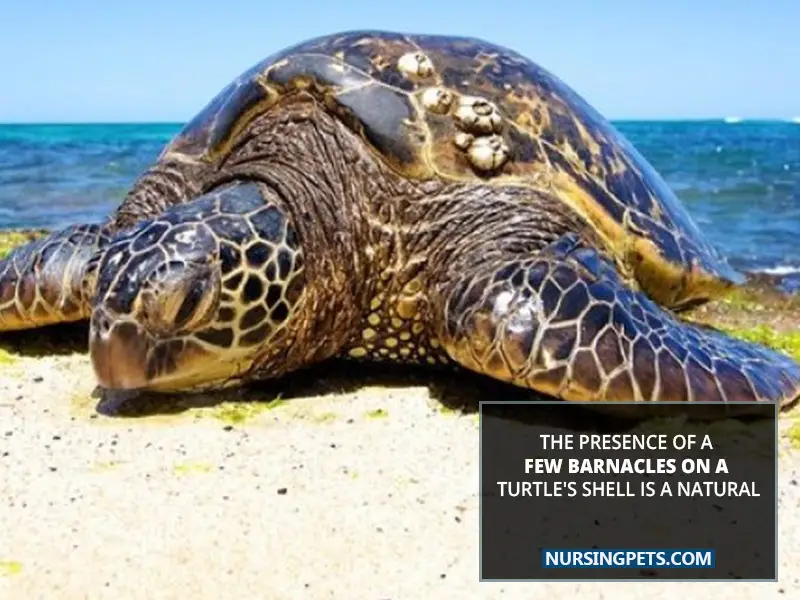
However, if the number of barnacles on a turtle increase, it could hamper the turtle’s movement, cause abrasions on the turtle’s skin, and even create drag in the water which may increase the energy expenditure required for swimming.
And this can lead to reduced foraging efficiency and potential health problems in the turtle.
Moreover, if the barnacles grow too much, they can create rough patches on the turtle’s shell, which can cause abrasions on the turtle’s skin as it moves around. The turtle’s skin can also become irritated if the barnacles start to pinch or scrape it.
Reasons Why Are Barnacles Bad for Turtle Shells?
Barnacles can be bad for turtle shells because they can attach themselves to the shell and create additional weight, which can make it harder for the turtle to swim effectively.
It can also cause damage to the shell and skin of turtles by creating abrasions or openings that can allow bacteria and other harmful organisms to penetrate the turtle’s body.

These openings can also make it easier for water to penetrate the shell, leading to dehydration and other health issues for the turtle. Additionally, barnacles can create a habitat for other organisms, such as algae or parasites, which can further harm the turtle’s health.
3 Common Types of Barnacles That Can Be Found on Turtles
There are more than 1,200 species of barnacles known to science. But not all of them live in the sea or attach to turtles. But here we cover some of them which are commonly found in sea turtles.

- Chelonibia testudinaria: This is the most common barnacle species found on sea turtles. It is a pedunculated barnacle, meaning it has a stalk that attaches it to the turtle’s shell. It is usually found on the plastron (underside) of the turtle’s shell.
- Chelonibia patula: It is also a pedunculated barnacle and is similar in appearance to C. testudinaria. However, it is typically found on the carapace (upper shell) of the turtle.
- Tetraclita stalactifera: This is a sessile barnacle species that is occasionally found on sea turtles. It has a conical-shaped shell and attaches directly to the turtle’s shell.
How Do Barnacles Attach To Turtles?
Barnacles are crustaceans that attach themselves to surfaces, such as the shells of sea turtles. They do this by secreting a cement-like substance also by using hooks and suckers that help them grip the surface.
And as mentioned, some barnacles cause little to no harm to the turtles, while others burrow into the skin of the host, causing discomfort and providing an open target area for infections
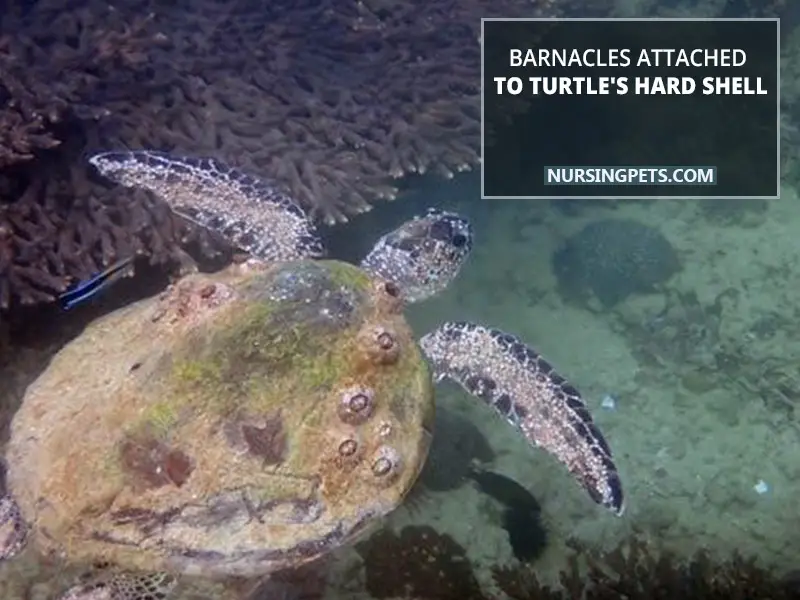
Now you might be wondering how exactly do sea turtles get barnacles or can barnacles grow on turtle shells?
When a turtle swims through these areas, also when the turtle rests on the sea floor or on rocks where it may come into contact with barnacles, and some of them may attach to the turtle’s shell. And, yes, they can grow on turtle shells.
How Can Barnacles Be Beneficial To Turtles?
Barnacles can be beneficial to turtles in several ways. At the same time, they are not typically harmful to turtles in small numbers. So are barnacles good for turtles? Let’s check out further.
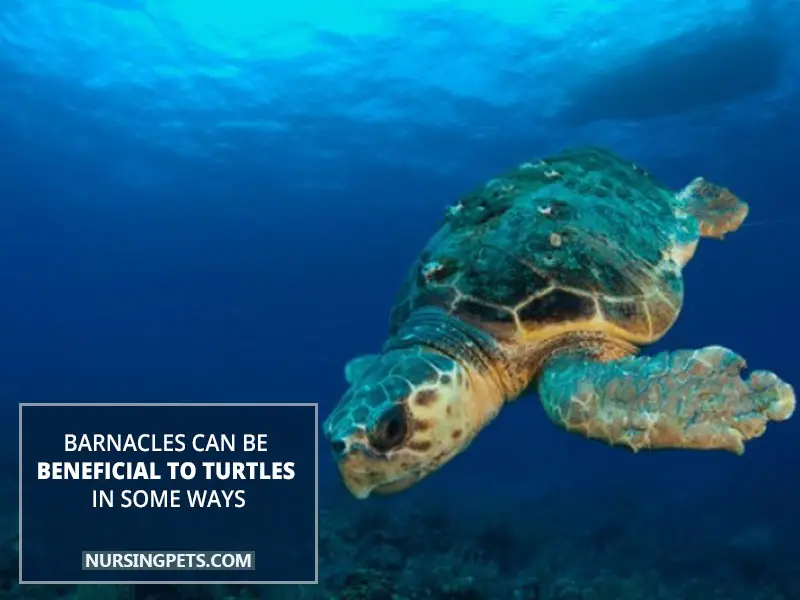
01. Camouflage
Barnacles on a turtle’s shell can help it blend in with its environment, making it less visible to predators. This can increase the turtle’s chances of survival.
02. Food Source and Habitat
An attached barnacle to a turtle’s shell can create a mini-ecosystem, attracting other small organisms like shrimp, crabs, and other invertebrates. This can provide additional food sources for the turtle and create a more diverse habitat.
It’s important to note that while barnacles can provide some benefits to turtles, excessive numbers can cause problems.
Is It Safe to Remove Barnacles from Turtles? Can You Do It?
Barnacles are tough organisms that cannot let go of their grip easily.
Removing barnacles from turtles can be safe if it is done properly by trained professionals.
Attempting to remove them, particularly from soft areas, may be very painful and harmful to the turtle. It should be done with caution and care to avoid harming the turtle.
And it’s important to ensure that the turtle is not injured during the barnacle removal process and that the shell is not damaged.
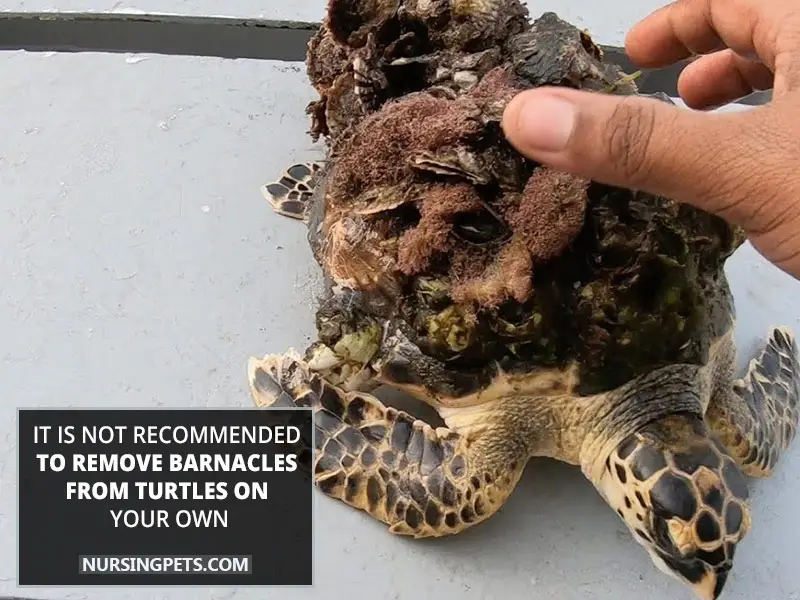
So, should you remove barnacles from turtles?
Well, it is not recommended to remove barnacles from a turtle’s shell. The reason is the turtle’s shell (carapace and plastron) is delicate, and the removal process can be extremely painful for the animal.
Moreover, removing barnacles can damage the turtle’s external and internal organs and leave it vulnerable to an open flesh wound that can get infected.
However, if there are so many barnacles present on the turtle that it affects its ability to swim, then it might be necessary to remove them
How to Remove Barnacles from Turtles?
As mentioned, removing barnacles from turtles can be a delicate process that requires proper technique, expertise, and tools to ensure the safety and well-being of the animal. Here are some steps you can follow:
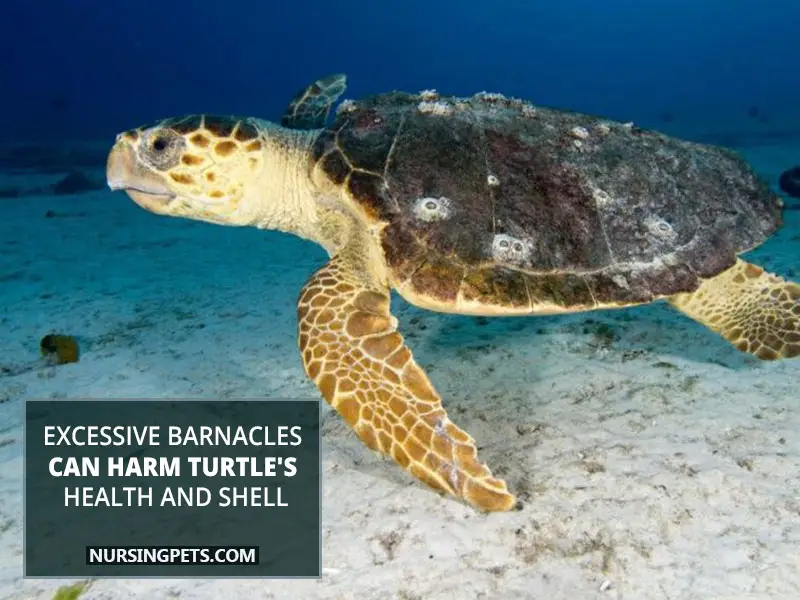
- Capture the turtle: If the turtle is in the wild, you will need to safely capture it first. This should be done by a trained wildlife professional to avoid injury to the turtle and to ensure proper handling.
- Soak the turtle: Once you have captured the turtle, place it in a shallow container of lukewarm water for at least 30 minutes. This will help to loosen the barnacles and make them easier to remove.
- Remove the barnacles: Using a plastic scraper or a soft-bristled brush, gently remove the barnacles from the turtle’s shell. Be careful not to scrape too hard or damage the turtle’s skin or shell.
- Release the turtle: Once the turtle has been cleaned and is free of barnacles, release it back into its natural habitat as soon as possible.
It’s important to note that barnacles can often be a sign of poor health in turtles and that removing them may only be a temporary solution.
If you notice that a turtle is covered in barnacles, it’s recommended to contact a wildlife rehabilitation center or veterinarian for further evaluation and treatment.
How Do Turtles Remove Barnacles?
Turtles may try to remove barnacles by rubbing against hard surfaces or by scratching them off with their claws or flippers. When female turtles have sex with their mates, some of the barnacles on their shells fall off.
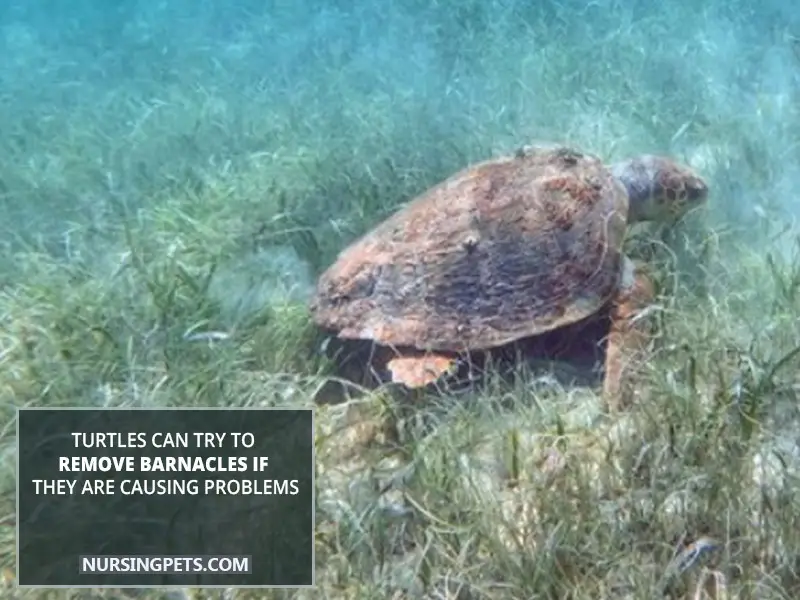
However, not all turtles have the ability to remove barnacles on their own, and attempting to do so can be stressful and potentially harmful to the turtle.
Frequently Asked Questions
01. Do barnacles die when removed?
When barnacles are removed from a turtle’s shell, they may die because they cannot survive without a hard surface to attach themselves to.
02. Do all turtles get barnacles?
Not all turtles get barnacles, but some species of turtles are more prone to them than others. Turtles that live in coastal or brackish waters are more likely to have barnacles or other organisms on their skin and shells.
03. Are there other factors that can harm sea turtles besides barnacles?
Yes, sea turtles face a variety of threats in their natural habitats, including habitat loss, pollution, climate change, and overfishing.
04. Can barnacles kill a turtle?
Generally, barnacles do not kill turtles. However, sometimes, infestations lead to infections, which can kill turtles. But barnacles are not life-threatening to turtles if they are few or small.
Final words
In conclusion, while barnacles are commonly found on the shells of sea turtles, they are not necessarily bad for the turtles. It may provide some benefits, such as increased buoyancy and protection against predators.
However, excessive barnacle growth can harm the turtle’s health by adding weight, hindering movement, and causing irritation or infection.
Therefore, researchers and conservationists must continue to examine the effects of barnacles on sea turtles and create efficient barnacle management measures when needed.
Ultimately, the well-being of these magnificent creatures should always be a top priority.
Article References:
- Oliveridleyproject.org/ufaqs/what-are-barnacles-and-why-do-they-attach-to-sea-turtles
- Oceanservice.noaa.gov/facts/barnacles.html
- Academic.oup.com/iob/article/3/1/obab002/6129261
- Localocean.co/2014/09/barnacles/
- Researchgate.net/figure/22-Soaking-the-seaturtle-in-freshwater-helps-loosen-barnacles-and-other-epibiotes-A_fig11_267567399
Image Source:
- Canva.com/photos
- Stock.adobe
- Youtube.com

